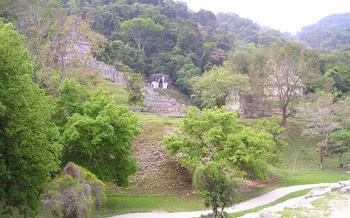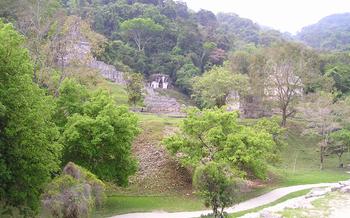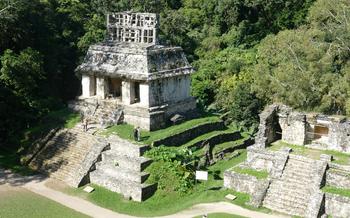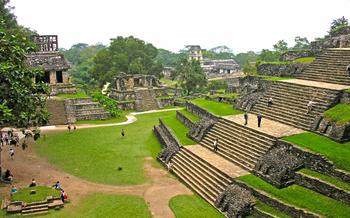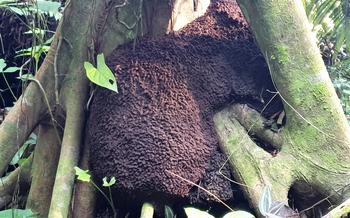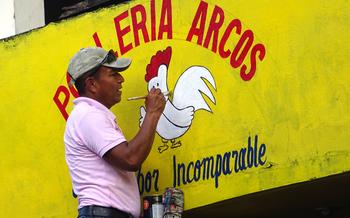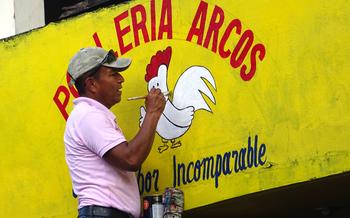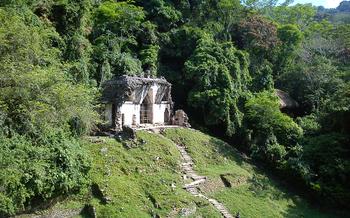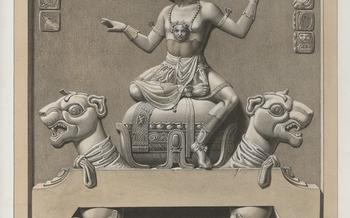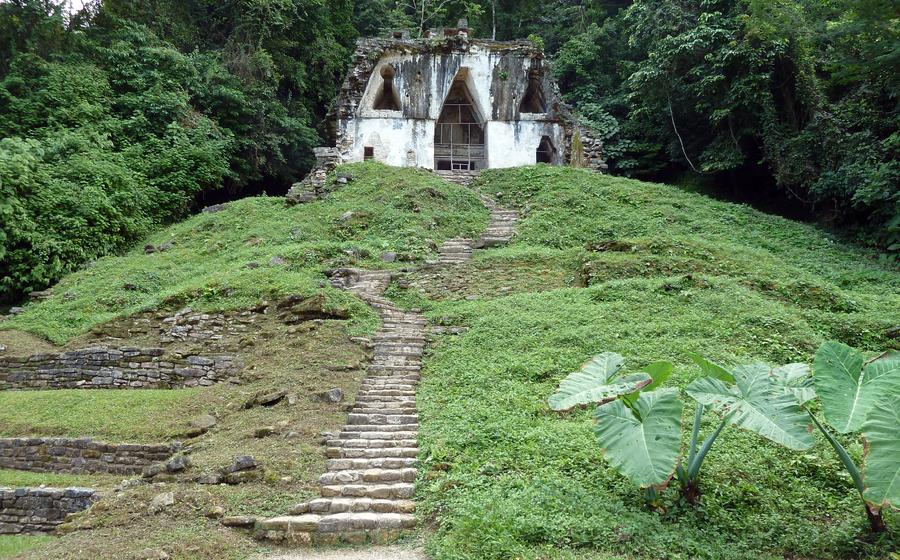
Temple of the Foliated Cross
- History of the Temple of the Foliated Cross
- The Foliated Cross
- Interior Explorations
- The Temple's Role in Mayan Society
- Restoration and Conservation Efforts
- Exploring the Palenque Archaeological Site
- The Surrounding Natural Beauty
- Local Culture and Traditions
- Accommodation and Dining Options
- Additional Tips for Visitors
- Photography and Videography Guidelines
- Sustainable Tourism Practices
- Insider Tip: Unveiling Hidden Gems
History of the Temple of the Foliated Cross
Emerging from the depths of the ancient Mayan civilization, the Temple of the Foliated Cross stands as a testament to the architectural prowess and spiritual beliefs of this enigmatic culture. Constructed during the 7th century AD under the reign of King K'inich Janaab' Pakal, the temple's origins are shrouded in mystery and wonder. Its name, derived from the intricately carved cross-like symbol adorning its interior, holds profound significance, alluding to the convergence of the physical and spiritual realms.
The temple's architectural style embodies the distinct characteristics of the Late Classic period, showcasing refined craftsmanship and elaborate ornamentation. Its towering presence, adorned with intricate carvings, sculptures, and bas-reliefs, invites visitors on a journey through time, revealing glimpses into the rich tapestry of Mayan beliefs and traditions.
The Foliated Cross
The Temple of the Foliated Cross owes its name to a beautifully preserved carving located within its interior. The Foliated Cross is a unique symbol found only in Palenque and its meaning remains a subject of debate among scholars. Some believe it represents the World Tree, a sacred symbol in Mayan cosmology that connects the underworld, earthly realm, and heavens. Others suggest it symbolizes the four directions or the four winds. The cross is intricately carved with images of a human figure, possibly a ruler or deity, surrounded by intricate foliage and mythical creatures. Its placement within the temple, above the entrance to the inner sanctum, suggests its profound religious significance. The Foliated Cross stands as a testament to the artistic prowess and spiritual beliefs of the ancient Maya.
Interior Explorations
Ascending the steep steps, visitors are awestruck by the temple's interior, a labyrinth of chambers and passageways that reveal the intricate world of the ancient Maya. Skilled artisans adorned the walls with elaborate carvings and bas-reliefs, each stroke narrating stories and capturing the essence of their beliefs.
Archaeologists have unearthed a wealth of artifacts within the temple's chambers, including ceramic vessels, jade ornaments, and stone sculptures. These discoveries provide valuable insights into the rituals and practices conducted within these sacred spaces.
The layout and design of the temple are not merely architectural feats but also hold profound significance. The alignment of chambers and passageways corresponds with astronomical events, suggesting the temple's role as an observatory. It was here that Mayan priests studied the cosmos, tracking the movements of celestial bodies and using their knowledge to guide agricultural practices and religious ceremonies.
Exploring the temple's interior is a journey through time, where visitors become immersed in the spiritual and intellectual world of the ancient Maya. However, safety remains paramount. Visitors are advised to follow designated paths and adhere to guidelines to protect the fragile structures. Respect for the site's sacred nature is essential in preserving this invaluable heritage for generations to come.
The Temple's Role in Mayan Society
The Temple of the Foliated Cross was not merely a stunning architectural marvel but also played a crucial role in the religious, political, and social fabric of Mayan society in Palenque. It served as a sacred site for religious ceremonies and rituals, where Mayan priests and rulers sought divine guidance and performed rituals to honor their gods and ancestors.
The temple's intricate carvings and iconography depict scenes of important events, mythological tales, and the accomplishments of Palenque's rulers. These narratives served as a visual record of history and mythology, educating and inspiring the Mayan people.
Beyond its religious significance, the temple held political and social importance. It was a symbol of the power and authority of Palenque's rulers, who used the temple to legitimize their rule and maintain social order. The temple's construction required skilled labor and resources, highlighting the advanced organizational abilities of Mayan society.
The temple's location also suggests its connection to the Mayan underworld and afterlife beliefs. It is situated near a natural spring, which the Maya believed to be a gateway to the underworld. The temple's elaborate carvings and iconography may have been intended to guide the deceased into the afterlife or to honor their ancestors.
The Temple of the Foliated Cross also served as an astronomical observatory, with alignments that allowed the Maya to track the movements of celestial bodies. This knowledge was crucial for agricultural practices, religious ceremonies, and understanding the cosmos.
By delving into the temple's role in Mayan society, we gain a deeper appreciation for the complexity and richness of their culture. The Temple of the Foliated Cross stands as a testament to the Maya's spiritual beliefs, political power, and intellectual achievements.
Restoration and Conservation Efforts
The Temple of the Foliated Cross, like many other ancient Mayan structures, has faced significant challenges in preserving its integrity over time. The relentless forces of nature, including tropical storms, earthquakes, and the passage of time, have taken their toll on the temple's structures. The humid jungle environment has also contributed to the deterioration of the temple's intricate carvings and artwork.
To address these challenges, ongoing restoration projects have been undertaken by archaeologists and conservators to safeguard the temple's heritage. These projects involve meticulous cleaning and stabilization of the temple's structures, using specialized techniques to restore the original appearance of the carvings and bas-reliefs. The aim is to preserve the temple's architectural integrity while respecting its historical significance.
The restoration efforts also extend to the surrounding areas of the temple, including the excavation and preservation of ancient artifacts and inscriptions. These discoveries provide valuable insights into the temple's history, functions, and cultural significance. The collaboration between archaeologists, historians, and local communities is crucial in ensuring the successful restoration and preservation of the Temple of the Foliated Cross and other ancient Mayan sites.
Exploring the Palenque Archaeological Site
The Temple of the Foliated Cross is just one of the many wonders that await visitors to the Palenque archaeological site. This ancient city, once a thriving metropolis of the Mayan civilization, is home to a wealth of impressive structures, including temples, palaces, and pyramids.
Strolling through the site, you'll be struck by the intricate carvings and bas-reliefs that adorn the buildings, telling stories of gods, rulers, and battles. The Great Plaza, the site's central square, is particularly impressive, with its towering temples and surrounding structures.
Be sure to climb the Temple of the Inscriptions, one of the tallest structures in Palenque, for breathtaking views of the site and the surrounding rainforest. The temple is also famous for its elaborate stucco reliefs, which depict the life and accomplishments of the Mayan ruler Pacal the Great.
For a deeper understanding of the site's history and significance, consider joining a guided tour. These tours, led by knowledgeable guides, will provide insights into the lives of the ancient Maya and the culture that flourished here.
As you explore Palenque, take time to appreciate the surrounding natural beauty. The site is nestled within a lush rainforest, home to a diverse array of flora and fauna. Keep an eye out for monkeys, toucans, and other wildlife that call this area home.
The Surrounding Natural Beauty
The Temple of the Foliated Cross stands amidst the lush rainforest of the Palenque archaeological site. Visitors can immerse themselves in the verdant surroundings, teeming with diverse flora and fauna. The rainforest provides a sanctuary for a variety of animal species, including monkeys, toucans, and colorful butterflies. Birdwatching enthusiasts can delight in spotting over 200 species of birds that call this area home, including the majestic keel-billed toucan and the vibrant scarlet macaw.
Hiking trails meander through the rainforest, offering opportunities for exploration and adventure. Visitors can trek through the dense vegetation, discovering hidden waterfalls, crystalline streams, and scenic viewpoints that showcase breathtaking panoramas of the surrounding landscape.
Promoting responsible tourism practices is essential to preserving the delicate ecosystem of Palenque. Visitors are encouraged to stay on designated trails, minimize noise and waste, and respect the natural habitats of the wildlife. By embracing sustainable tourism practices, travelers can contribute to the conservation of this extraordinary natural heritage.
Local Culture and Traditions
Palenque's allure extends beyond its ancient ruins, as it remains a vibrant hub of living Mayan culture. The local communities have preserved their ancestral traditions, offering visitors a glimpse into a rich and diverse heritage. Engage with the locals to learn about their intricate weaving techniques, traditional music, and ancient rituals. Attend local ceremonies or performances to witness the vibrant expressions of Mayan spirituality and artistry. It's important to approach these interactions with respect and humility, observing cultural sensitivities and customs. By immersing yourself in the local culture, you'll gain a deeper appreciation for the enduring legacy of the Maya in Palenque.
Accommodation and Dining Options
When planning your stay in Palenque, you'll find a range of accommodation options to suit different preferences and budgets. From cozy guesthouses to luxurious jungle lodges, there's something for every traveler. For an immersive experience, consider staying in one of the locally-owned guesthouses or eco-lodges. These accommodations often provide a glimpse into the local Mayan culture and support the community.
For dining, Palenque offers a culinary journey that blends traditional Mayan flavors with international influences. Local restaurants serve up delicious dishes using fresh, locally-sourced ingredients. Be sure to try regional specialties like "pejelagarto," a fish from the Usumacinta River, or "pochuc," a flavorful pork dish. Several restaurants offer cooking classes, providing a hands-on experience for visitors who want to learn more about Mayan cuisine.
When choosing your accommodations and dining options, consider supporting local businesses that prioritize sustainability and cultural preservation. This helps ensure that the benefits of tourism are shared equitably and that the unique heritage of Palenque is preserved for future generations.
Additional Tips for Visitors
When exploring Palenque, it's essential to pack accordingly for the rainforest environment. Bring comfortable clothing, sturdy footwear, a hat, sunglasses, and a raincoat. Don't forget your sunscreen, insect repellent, and a reusable water bottle to stay hydrated.
Hiring a local guide can greatly enhance your experience. They can provide insights into the history, culture, and significance of the site, making your visit more meaningful.
Remember that Palenque is a sacred site for the Maya people. Be respectful of their beliefs and customs. Avoid disturbing wildlife or damaging the environment.
Also, remember to respect the site's integrity by not climbing or touching the structures.
Photography and Videography Guidelines
Respecting the cultural significance of the Temple of the Foliated Cross and the Palenque site as a whole, it is essential to adhere to specific photography and videography guidelines.
-
Regulations and Permits: Always inquire about any regulations or permits required for photography or videography at the site. Respect the guidelines set by local authorities to preserve the integrity of the ancient structures.
-
Ethical Considerations: Remember that you are capturing images of a sacred site with cultural and historical importance. Be mindful of the privacy of local people and ask for permission before photographing or filming them.
-
Respectful Techniques: Use non-invasive techniques and avoid using flash photography, as it can damage the delicate artwork and inscriptions. Tripod use may also be restricted, so be prepared to shoot handheld.
-
Sharing Responsibly: When sharing your images and videos, always credit the site and the local people you encountered. Tag your posts appropriately and use social media platforms responsibly, respecting the cultural significance of the site.
Sustainable Tourism Practices
As responsible travelers, it is crucial to prioritize sustainable tourism practices when visiting Palenque. Minimizing our environmental impact through responsible travel choices is essential. Opt for eco-friendly transportation options, such as walking or cycling, to reduce carbon emissions. Respect the natural beauty of the site by avoiding littering and using designated waste disposal areas. Support local initiatives that promote conservation and cultural preservation. These initiatives often involve community-led projects that directly benefit the local people and the environment. By choosing local guides, accommodations, and restaurants, you can contribute to the local economy and support the preservation of traditional practices. Encourage fellow visitors to be mindful of their actions and choices, creating a ripple effect of sustainability. Together, we can ensure that Palenque remains a thriving cultural and natural wonder for generations to come.
Insider Tip: Unveiling Hidden Gems
Beyond the renowned Temple of the Foliated Cross, the Palenque archaeological site holds a treasure trove of hidden gems waiting to be discovered by discerning travelers. Venture off the beaten path and explore the Temple of the Inscriptions, a marvel of Mayan architecture that houses the tomb of the great king Pakal. Admire the intricate carvings narrating Pakal's life and journey into the afterlife.
For a serene escape, seek out the Temple of the Cross Group, where you can bask in the tranquility of its lush surroundings. Capture the essence of Palenque's natural beauty by embarking on a hike through the rainforest, where you may encounter exotic wildlife and stumble upon hidden waterfalls.
To delve deeper into the local culture, visit the nearby village of San Antonio del Palenque. Interact with the friendly locals, learn about their traditions, and savor the flavors of authentic Mayan cuisine. Embrace the opportunity to witness traditional ceremonies or performances, gaining a profound understanding of the region's rich cultural heritage.
